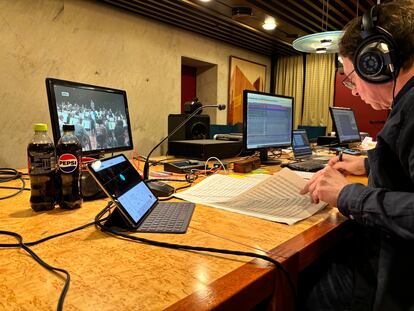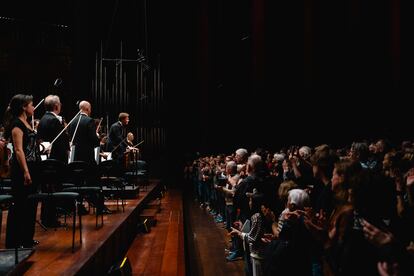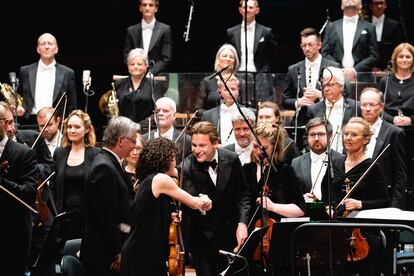“I have never seen any conductor achieve something like this from an orchestra or in this way.” Jørn Pedersen confesses this, in the technical room of the Konserthus in Oslo, on the morning of Saturday, April 27. The Norwegian producer, who has been releasing great conductors and soloists for 35 years on record labels as important as EMI/Warner and Decca, is finalizing the equipment for the final session of the Symphony no. 7, Leningrad, by Dmitri Shostakovich. A sound portrait of the brutal Nazi siege of the Soviet city, during World War II, which has been the focus of MT Anderson’s recent book, Symphony for the city of the dead (It’s Pop Editions).
Klaus Mäkelä arrives half an hour early. The young Finnish conductor, 28 years old, who has made headlines in the press around the world after his appointment as future principal conductor of the Amsterdam Concertgebouw and the Chicago Symphony, receives EL PAÍS with natural sympathy and warmth. He dresses casually and shares some delicious jubileumsbolle, cinnamon buns with vanilla cream, which he brought to sweeten the morning. Next, she spends a few minutes with Pedersen reviewing the passages he must re-record in front of the score.
“My main dedication now is to the two orchestras that I own, the Oslo Philharmonic and the Paris Orchestra, with which I still have many plans ahead,” Mäkelä insists. He talks about touring with both of them around the summer. with the french will return, at the end of June, to the Granada Festival and then he will visit Aix-en-Provence and the BBC Proms in London; With Oslo he will travel a few weeks before through Amsterdam, Paris and Vienna, conducting and playing the solo cello part of the Double concert of Brahms.
He also has two album releases planned this year with the Oslo Philharmonic, always with Decca. “In June a CD of violin concerts that we recorded with Janine Jansen as soloist will be published and, in August, the first album of our complete cycle of Shostakovich symphonies will be released with the Quarterthe Fifth and the Sixth”reports the Finnish director. The Seventh will appear, next to the Tenth, in another later release, as clarified by Dominic Fyfe, director of Decca Classics, present these days in Oslo. And, in 2025, they hope to continue the cycle with the Firstthe Eleventh and the Fifteenthcoinciding with the 50th anniversary of the composer’s death.
“It’s a difficult symphony,” Mäkelä mutters about the Seventh when Pedersen points out some problematic passages versus the Sikorski edition of the score. They have been working since Monday and the Finnish director has already directed two live performances, on Thursday and Friday. “We usually record rehearsals, but the main takes for the album come from performances with the public,” says the producer. However, Saturday’s final session is of fundamental importance. “In addition to specific corrections, we aspire to redo some passages so that they work well on the album, since the orchestra is used to playing for the public and it is different to do it for the microphone,” Pedersen continues.
“I love the phonographic medium,” emphasizes Mäkelä, who is involved in the entire recording process. He talks about favorite versions of him. He talks about his favorite recordings of the work, and mythical recordings of the work come to the fore. Yevgeny Mravinsky with the Leningrad Philharmonic and of Leonard Bernstein with the Chicago Symphony, but immediately exhibits its own interpretive solutions. His producer explains the intense joint post-production work: “Klaus does not limit himself to sending me a list of things that need to be polished, but he listens to each edit many times until the result matures. And then we sat down together with time to work on the final master.”

The producer insists on the admirable results that the young Finn achieves from the first rehearsal. “On Monday we made a complete take of the symphony that could be used for the final edition, but Mäkelä has continued to refine every detail,” he says. The work environment is ideally friendly and the orchestra is as motivated as it is inspired under his baton. This is confirmed by Belgian clarinetist Pierre Xhonneux, who has worked at the Oslo Philharmonic since 2015. “He always speaks to us in a simple and friendly way, you have the impression that his gaze accompanies every note we play and his gestures connect us with the music, because it seems to flow through him,” he explains. Xhonneux acknowledges that he maintains a WhatsApp forum with some colleagues from the Paris Orchestra to compare what he does there. And he confirms that the fascination is identical.
The Norwegian audience at the Konserthus is also captivated after each performance by the head of its orchestra. At the end of the two concerts with this Shostakovich symphony, on Thursday and Friday, April 25 and 26, the 1,600 people who fill
ed its capacity ended up standing cheering what they heard with rhythmic applause. The director begins the work by adopting a flexible posture on the podium, with his legs wider than normal. We immediately see that he does this to be able to turn quickly and reach each of the 100 musicians in the orchestra with his gestures, which, in addition to extensive percussion, includes an additional ensemble with trumpets, horns and trombones that play standing in the background. .
He allegretto initial already put the cards on the table. The Finn handles the textures beautifully, with the two gentle opening songs, which he polished on Saturday, in the session without an audience. In fact, for this work he has counted on the German violinist Sarah Christian, as concertmaster guest, which adds a wonderful bite to the rope. But in Mäkelä’s version the control of the speech is impressive, from beginning to end. We saw it in the construction of the impressive development, when a box marks the rhythmic figure of a march, in pianississimo (ppp)and is repeated insistently, with the progressive incorporation of all the instruments of the orchestra, until it grows into a fortississimo (fff) that discharges in an overwhelming climax.

Shostakovich always joked about the similarity of that passage to the Bolero by Ravel. But in Sovetskoe iskusstvo, acknowledged that it actually evokes “the irruption of war into peaceful life.” The realization of that overwhelming sound moment was so perfect in Friday’s concert that Mäkelä did not have to retouch it again in Saturday’s session. The second movement acquired the jumping air of a scherzo, with that dance of the violins that leads in a strident and sardonic dance starring the requinto that Xhonneux played. In fact, the last minutes of Saturday were dedicated to polishing the most exposed passages of this movement, with a jubilant orchestra, which celebrated having reached the end of the recording.
The third movement was another of Mäkelä’s main achievements. Here Shostakovich, as he confessed in a radio message, composes a heartfelt portrait of his city on the banks of the Neva River. At first he uses a brown and earthy tone, through chords on the wood with horns and harps, but immediately we heard its light with that beautiful solo that the flutist played masterfully Chinese Ting-Wei Chen. The Finnish master once again impressed with his sonorous account of Petersburg architecture. He led it to a fierce climax that then retreats into a beautiful passage sung by the excellent viola section of the Norwegian orchestra, led by the British Catherine Bullock-Bukkøy.

And the story of the final victory was missing, of the allegro non troppowhich continues without pause adage. A movement that Mäkelä starts by intensifying the gloom along with the frenetic dance that follows. The rhythmic climax, with that violin passage accompanied by pizzicato clicks of the rest of the string, improved a lot in Saturday’s shots. But, once again, the story was the strong point: the reflection that unfolds at the end about the cost of a war, so present today. A tension that grew without exaggeration until that liberating C major that Shostakovich sprinkles with dissonances, because in a war the winners also lose.
At the end of Saturday’s session, after four intense hours of work, Mäkelä was still fresh and already thinking about his next recording, in this case with the Paris Orchestra: the fantastic symphonyby Berlioz, and The waltz, by Ravel. But we left him surrounded by the musicians of his Norwegian orchestra, becoming one of them after stepping off the podium.
All the culture that goes with you awaits you here.
Subscribe
Babelia
The literary news analyzed by the best critics in our weekly newsletter
RECEIVE IT
Subscribe to continue reading
Read without limits
_
#Facing #big #orchestra #Shostakovich #age #genius #Klaus #Mäkelä
